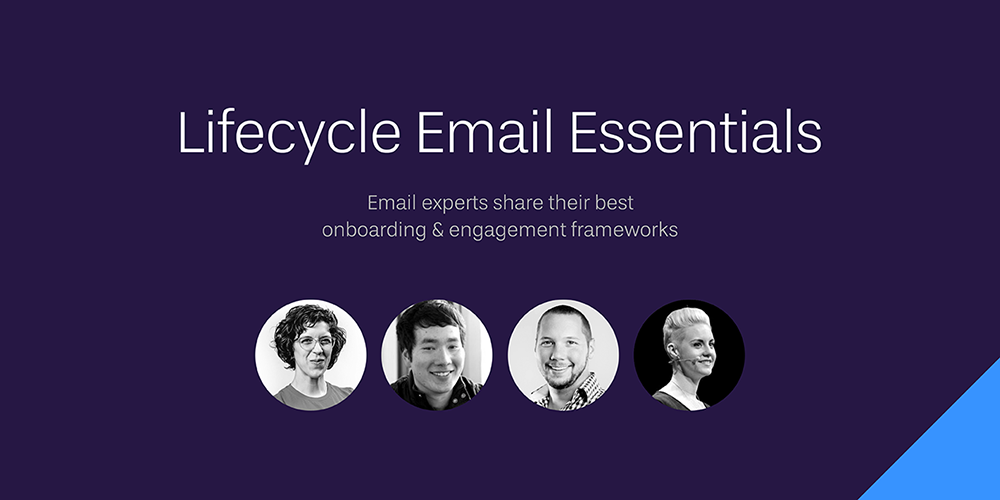When making decisions, it’s important to take your customers’ opinions — including their actual words! — into consideration. But according to Ferdinand Goetzen of Reveall, only a small percentage of SaaS companies do it in practice.
What exactly is “Voice of the Customer” (VoC), and how can you leverage it for your product strategy and marketing?
Ferdinand and Jane talk about why SaaS companies should view it as an integral part of the business and tips on how you can start processing this wealth of data.
Watch the full recording of the workshop below, or read on for the key learnings.
Don’t wait for the muse. Apply this step-by-step method to write high-performing email campaigns in hours, not weeks.
What is the Voice of the Customer?
Ferdinand shares that a lot of people treat it as an academically complex topic, but it’s literally just the Voice of the Customer, or essentially what the customer says:
“It’s the opinions, needs, desires expressed by the customer. It essentially encompasses all the feedback that you get from your customers regarding their needs, expectations, and feelings towards your products and services and experiences for that matter.”
Ferdinand points out that VoC doesn’t exclusively mean customer interviews. These could also mean sales conversations, customer support tickets, or reviews written on sites like Trustpilot.
Listening to customers and getting their feedback can be incredibly valuable, but he emphasizes that:
“It’s important to do it well. It’s important to treat it right.”
And when done right, companies can reap great results. A study says that best-in-class VoC users enjoy an almost 10-times-greater year-over-year increase in annual company revenue compared to others.
Why does it matter?
Here’s why VoC is becoming more important these days: According to Forbes, 76% of consumers expect organizations to understand their individual needs.
Ferdinand says:
“This is where the need for good UX, the need for good design, the need for good usability, intuitive interfaces is just higher than ever before because the field of UX is growing. The amount of professionals working in each company (is growing). The standards have risen a lot in the last 10, 15, 20 years. Companies and customers are really quickly adapting to those expectations.”
Why are companies struggling with it?
While it’s good to see that about 95% of companies frequently listen to their customers only 29% of companies incorporate VoC into the decision-making process.
But Ferdinand explains that the reason for the drop in numbers is not because companies don’t want to, but because it’s challenging and difficult.
“We’ve done the research ourselves at Reveall and we found that when we talked to stakeholders and really big companies across industries. We asked over 30 of them: ‘on a scale from 1 to 10, how important is it to take the customer opinion into account when you take action?’ And the average grade was over a nine out of 10. This 29% is not because they don’t like it. It’s because it’s difficult to do.”
He shares that one of the reasons why it’s challenging is because customer feedback involves a lot of unstructured data which requires a lot of resources to process.
“It’s usually buried in larger bits of content. So it’ll be a long customer review, a detailed customer support ticket, a 20 to 30-minute interview, or an hour-long focus group. It’ll be in the form of hundreds of survey responses or feedback requests, NPS responses. It usually requires a bit of digging, a bit of mining, which is time-intensive and also very large in terms of kind of the amount of information you need to handle.”
Because of this, the company loses a lot of information as the data gets siloed into different departments. And instead of sharing this wealth of data with each other, the different departments are having their own internal conversations.
“So sales, marketing, customer success, product — they’re all having their own conversations and they’re not sharing those insights with each other. And it (the data) usually ends up at the bottom of some kind of Notion document or in a Google Drive folder that nobody reads.”
Another frustration that companies have with this huge amount of data is that they’re just doing a lot of repeat research.
“You’re trying to find out information that you already — kind of — have. There’s already that customer conversation, that sales call, that customer support ticket, that review that is iterating what you’re trying to find out. It’s just difficult to get a full 360 view of that. And even if you do that — turning that into real action, structuring it, and then understanding how does this convert into activities actions we should take. It’s a whole other challenge altogether.”
Tip 1. Create a clear process
With all these challenges with processing VoC data, Ferdinand says one of the ways to overcome them is to establish and implement a clear process.
“One of the ways to solve that is to create a clear process that systematically turns this Voice of the Customer data into action. And the process we follow, and this is kind of what we built our product around.”
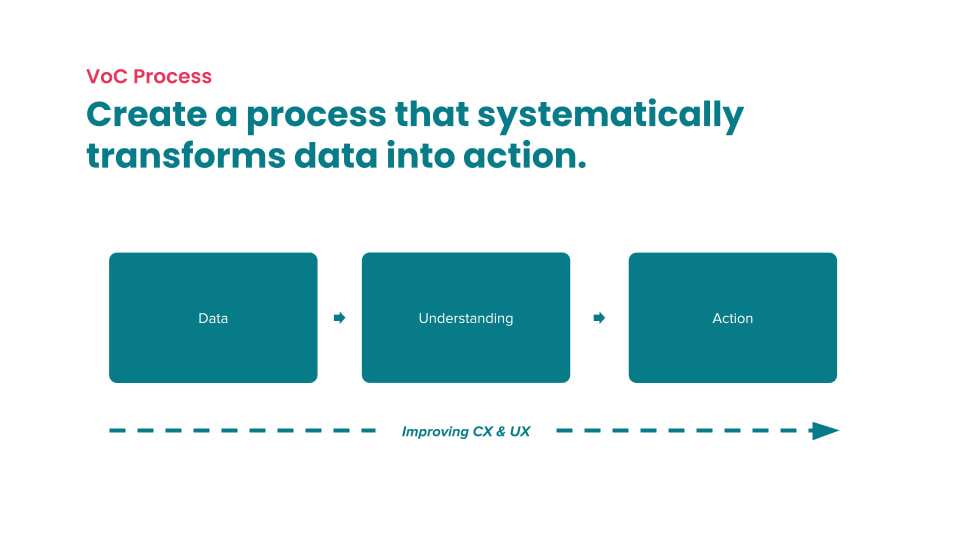
He shares that 95% of companies are already gathering customer data. The next steps in this process would be to:
- Put the data in one place.
- Structure the data.
- Interpret the data.
- Create clear actions.
“It’s just something that you need to do. Half of the battle is just sitting together and saying: ‘let’s do this.’ And then building the process. Of course, it isn’t a picnic. It doesn’t take two seconds. It takes some time, but already just agreeing as a company that you need to listen to the Voice of the Customer and implement it in your decision-making, that’s already half the battle.”
Turning customer data into clear action steps is essentially what their platform, Reveall is all about.
Tip 2. Avoid leading questions
Ferdinand says that asking the right questions is crucial if you’re getting your VoC data from customer interviews, surveys, forums, and the like.
“When you ask leading questions, when you ask biased questions, when you ask problematic questions — you do not get good input.”
While some in the UX and product design world would believe the quote: “look at what your customers do, and not what they say” — which is a direct criticism at VoC.
But Ferdinand believes that VoC only becomes problematic when: wrong questions are asked or right questions are asked the wrong way.
Take for example this set of UX questions from Miro:
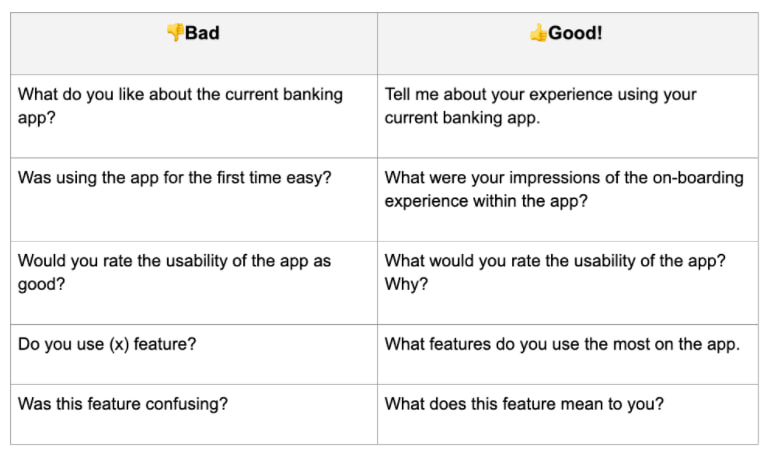
If you noticed on the first row, instead of asking customers what they like about the current banking app, it would be better to ask them about their general experience of using the app. This is to remove the notion that there is something to like about the app.
“Creating unbiased questions already helps to keep the Voice of the Customer as clean as possible.”
Tip 3. Use a VoC template
Ferdinand shares that companies can already start working on their VoC data by using Reveall’s free VoC template.
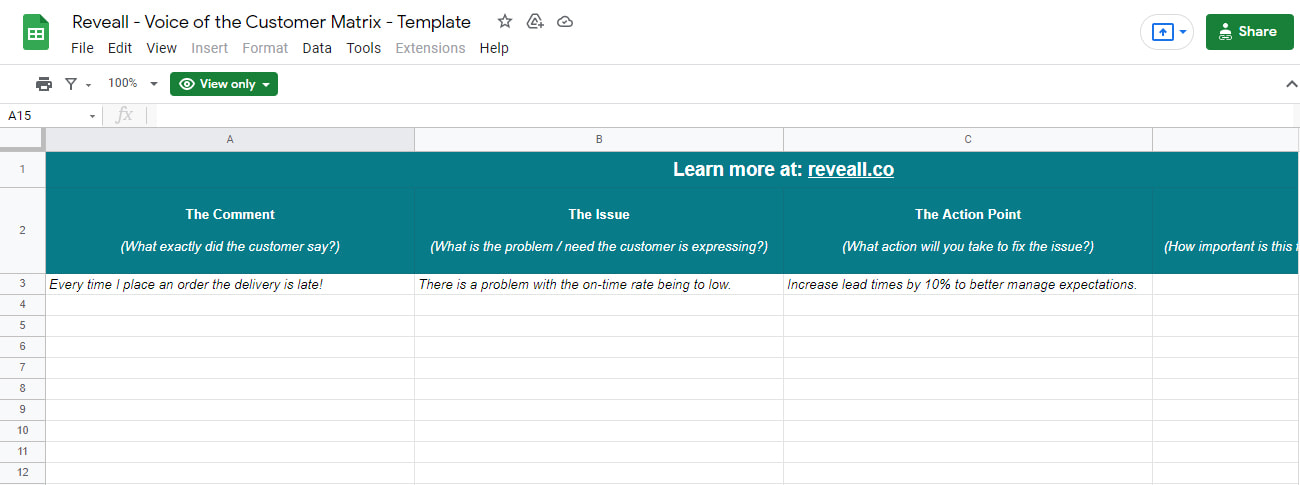
“This is really simple. It basically brings the Voice of the Customer together. You try to define what is the underlying problem of the comment that the customer made, and you try to create an action point to address that problem, and then you prioritize them.”
He shares that this template can be used by any company of any size. They could do this regularly, at a schedule that works for them.
“It’s not something you have to do all the time. You can just take an hour every week, every month, whatever fits you.”
During these regular sessions, you can do things like write down all customer comments and go through all the support tickets. These will help you not only in mapping out the problems but map your solutions as well.
Tip 4. Add context to VoC using customer data
Ferdinand says that apart from listening to what the customer says, you also have to look at what they’re doing. He advises complimenting and contextualizing VoC data with external and behavioral data sources like:
- A/B tests
- Conversion rates
- Product metrics
- User activity
- Analytics
- Desk research
- Market research
- Industry reports
“That’s also something we try to do within our platform: help you bring this Voice of the Customer and the behavioral information and the market information and bring that together to create a full picture. And that’s something that you should always aim to do.”
Aside from helping you make sense of your VoC data, looking at other data sources will help you see the bigger picture.
“There is a limitation of course, to your customer’s experience and their perspective. So you always need these external factors to complement. And of course, the Voice of the Customer is something mainly geared towards your customers, but you should also be talking to the people who are not your customers. Who are the companies that in a sales call, you’re losing the deal, or they choose not to sign up, or they end up churning?”
Ferdinand shares that they’ve built a community around their product so they can talk to people who might not have the bias of their customers.
“At the end of the day, the principles of Voice of the Customer need to be applied beyond your current customer base — to understanding the entire market and the people that surround your customers. They might not necessarily be taking the same actions.”
Tip 5. Use the right tools to help with VoC data
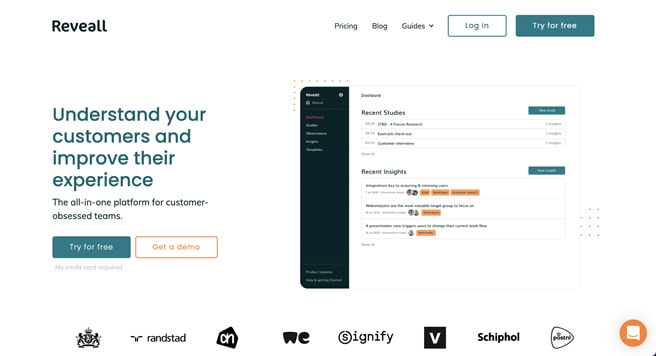
Tools like Reveall can help you collect your VoC data effectively, process it, and more.
“We help you bring all of that information into one place within our platform and then we help you complement that with other pieces of information. So you can upload market research reports, or you can. You can upload results of A/B tests or surveys, and you can complement some of those Voice of the Customer data points with other data points to create a really full picture interpret and take action on them.”
But if you’re operating on limited resources, Ferdinand emphasized that not having a nifty tool like Reveall is not an excuse not to do VoC research. You can use their free VoC template to get started.
Tip 6. Involve the people who will benefit the most from understanding the results of your VoC research
But which group of people in the company should be doing this?
Jane shares that it seems like many different people would be involved like customer success, customer support, the product team, and more.
Ferdinand says that it’s a difficult question to answer. Ideally, every team in the company should be involved in doing the VoC research. But since that’s not realistic, he shares that those who will benefit the most from understanding the results should be involved in the process.
“I think the goal is that different departments come together because I think the biggest problem right now is silos. Everyone’s talking to the customer and that information sits in each department. I think that’s currently the biggest shortcoming. That’s the biggest limitation is that people are just split off from one another and not sharing that information. So create a session once a week, once a month, even once a week where you bring everything together.”
While the process might be tedious, he shares that the insights you get will be very rewarding:
“That is a frustrating and tedious task. But you just get so much insight at doing that and it often will validate or invalidate ideas you have. It’ll spark new ideas.”
Don’t wait for the muse. Apply this step-by-step method to write high-performing email campaigns in hours, not weeks.
Tip 7. Synthesize information before discussing it in a group
With the huge amount of information involved in the process, Jane asked Ferdinand if there’s a better way to extract and condense the key takeaways from interviews or sales demos.
Tools like Reveall makes this process easier for companies.
Alternatively, Ferdinand suggests making your VoC research sessions look like a focus group session where you just bring about four to five people together.
“Everyone synthesizes the information themselves and presents it, and then you try to create a report out of it together. That’s something you can do once a week.”
Tip 8. Tie your VoC research to a goal
Without a clear goal, VoC research could become tedious and tiring very quickly. This is why it’s best to work on a project basis:
“You can take a continuous approach, or you can also take a product project-driven approach. So generally you’re trying to find something out. You’re trying to learn something. You’re trying to do something. So you can take a customer segment or persona research, or there are all kinds of different themes. You can build around a project and then you gather the information on the basis of that theme. You map it out and then you make decisions on it.”
Jane asks, what about more mature companies who are sitting on a wealth of years-old data. Ferdinand says that you can still use it, as long as you tie to your current purpose:
“You could also do this reactively. If you’re building a new feature or a product, or you’re changing an experience, you can map back to the original information. Try and find the data afterward to validate the ideas you have or to invalidate the ideas that you have, or to guide or mold the ideas you have. Starting with a solution and trying to validate it with data is always easier, of course. If you’re starting with the data and then trying to gain ideas out of it, customer journey mapping can be a great tool.”
Tip 9. Treat VoC as part of company culture
What would be the overall recommendations for growing SaaS companies, so they can manage this kind of knowledge across people? The first step would be agreeing that doing VoC research is important. Everything else will follow:
“I think the first step is really agreeing that it’s important and worth investing time and effort. The second is to put someone in charge of coordinating that process: it doesn’t have to be a particular person. Ideally, it should be a person who works the most with customer data because they’re gonna be more intrinsically motivated to run this process.”
After taking these two main steps, you can then decide on the process and the tools you use for VoC as these are only secondary concerns. Ferdinand emphasizes having everyone on the same page if you want it to work:
“Make it a core part of your strategy, a core part of your culture and identity, and then rally the people around it, pick a person to own this process and drive it.”
Tip 10. Prioritize your best customers
Any company might tell you that they always put their customers first. But how do you deal with a large customer base? Should you listen to everyone?
Ferdinand shares that after reading Peter Fader’s book, Customer Centricity, he gained a different perspective of what the term means.
“Customer-centric doesn’t mean serving all your customers. It means serving your best customers, and using that information to take action. I think that’s really important because when you’re dealing with all this. You need to prioritize who you’re looking into and who you’re trying to help.”
The book cites Tesco, one of the leading supermarkets in the UK, as a good example of a customer-centric company. Tesco lays out its stores a certain way to build an experience that serves its best customers.
But being customer-centric doesn’t mean you don’t care about the other segments below your best customers. It’s all about the segmentation of customers and giving support accordingly:
“That doesn’t mean you say to all the other customers: ‘go away, we don’t care.’ You serve all the customers. Having good customer service is a great principle to have, serving old customers well is a great principle to have, but what I give is a really concrete example. There’s a lot of companies that pride themselves in customer support. And at some point, their customer base grows and their support team can’t keep up and starts to suffer. Whereas what a really customer-centric company by Peter Fader’s definition would do is to create different layers of customer support, which are then in line with the kind of customer segments that you’re addressing.”
Ferdinand gives an example of having priority customer support for your best target customers (ie. paid for a higher package) while the freemium users can have an automated support ticketing system.
He also says that customer service and customer centricity are both important, but they are not the same thing. And so is customer voice and customer data — which are also not the same thing.
“It’s not just what they’re saying. Who is saying it really matters.”
Tip 11. Segment your best customers
Jane and Ferdinand both agree that customer segmentation will help define and prioritize your best customers.
But the definition of best customer doesn’t necessarily mean that they spend the most money:
“You might be a SaaS company focused on SMBs, and then you have a corporate bank that’s spending 10 times more than everyone else, but they’re constantly lacking features. There are things that they can’t manage. So defining the best customer doesn’t necessarily mean it’s the customer that pays the most.”
Defining your best customer involves a combination of things such as:
- They are paying customers
- They are easy to convert
- They understand the product
- Has a great experience with the product
- Has a good net promoter score (NPS)
- Has a healthy relationship with customer success and customer support
- Asks enough questions to show that they’re engaged in trying your new features
Aside from defining what factors you should include when creating your segments, Ferdinand says that the key is to understand which segments should be prioritized (ie. are financially beneficial, easy on customer support):
“It’s important to understand these dynamics: who’s most active, which customer segment is referring the most to other customers. And if you then have one customer segment that stands out on a number of these factors, they’re probably the voices I would listen to the first and the most.”
Jane shares that it’s also important to look at segmentation in terms of the lifecycle stage:
“We always encourage people to also segment their user base by lifecycle stages. And that’s also important. Like at what stage of the journey are they in? Being onboarded or being on the app for two years — those are different persons who can have different insights.”
Read our guide on planning customer segments.
Tip 12. Ask everyone in the company: “when did you last speak to a customer?”
Here’s another thing you can do immediately to jumpstart your VoC research: send a survey to everyone in the company asking them how many times per month did they speak to a customer in the last three months.
Ferdinand has personally tried this at his previous company:
“The results will have their own impact. Everyone thinks they talk to the customer more than they do. We did this once at one of my previous companies where we asked everyone: how often do you talk to the customer? And of course, salespeople talk every day. But you’ll find some people who will jump on the customer-centricity train very quickly. But if you ask them, when did you last speak to a customer? They’ll say: ‘well, I kind of spoke to a customer four weeks ago and then eight months ago or whatever.’ I think that’s the most important if people aren’t talking to the customer every day, or every week, then that’s the first thing to fix.”
After this, your team can now focus on getting all the VoC data segmented and organized.
Additional resources
Jane and Ferdinand recommend these resources for customer-related research:
- The Mom Test by Rob Fitzpatrick
- Lean Customer Development by Cindy Alvarez
- The Customer-Driven Playbook by Travis Lowdermilk and Jessica Rich
- Customer Centricity by Peter Fader
Learn more from Reveall
Reveall is an all-in-one platform that can help you understand your customers and take action steps in improving their experience. If you’d like to learn more about the core ideas and strategies on the Voice of the Customer, you can read their comprehensive guide on the subject.
Don’t miss out on new articles. Subscribe to our newsletter and get your monthly dose of SaaS email marketing insights.





